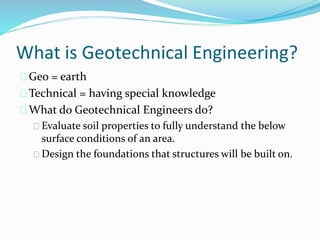Not known Factual Statements About Geotheta
Not known Factual Statements About Geotheta
Blog Article
10 Easy Facts About Geotheta Shown
Table of ContentsAll About Geotheta3 Simple Techniques For GeothetaThe Ultimate Guide To GeothetaNot known Facts About GeothetaSome Known Factual Statements About Geotheta

They carry out website investigations, accumulate samples, perform research laboratory examinations, and evaluate information to review the suitability of the ground for building jobs - Geo Tech Engineer. Based on their findings, geotechnical designers provide referrals for foundation design, slope security, retaining structures, and mitigation of geotechnical dangers. They work together with various other specialists, such as engineers, structural designers, and building groups, to guarantee that geotechnical considerations are incorporated into the overall project style and implementation
By analyzing the behavior and residential properties of dirt and rock, they can determine potential geotechnical dangers such as landslides, soil negotiation, or slope instability. Their experience helps avoid failings or crashes that might jeopardize lives and residential property. Here are some in-depth duties and obligations of a geotechnical designer: Website Investigation: Geotechnical engineers conduct website investigations to collect data on subsurface problems.
They interpret the data to understand the homes and behavior of the soil and rock, including their stamina, permeability, compaction features, and groundwater problems. Geotechnical Evaluation and Layout: Geotechnical designers evaluate the information accumulated throughout website examinations to examine the stability and suitability of the site for construction projects. They carry out geotechnical calculations and modeling to assess aspects such as birthing capability, negotiation, incline security, side earth stress, and groundwater circulation.
Not known Facts About Geotheta
Foundation Layout: Geotechnical engineers play an essential duty in making structures that can securely sustain the intended structure. They assess the soil conditions and load needs to figure out the appropriate structure kind, such as shallow structures (e.g., grounds), deep foundations (e.g (https://geotheta.godaddysites.com/f/why-geotechnical-engineers-are-your-projects-best-friends)., heaps), or specialized strategies like dirt renovation. They take into consideration factors such as negotiation limitations, bearing capacity, and soil-structure interaction to establish ideal foundation designs
They review building and construction strategies, display site tasks, and carry out field examinations to verify that the design recommendations are adhered to. If unforeseen geotechnical issues arise, they evaluate the circumstance and provide referrals for remediation or adjustments to the layout. Risk Evaluation and Reduction: Geotechnical engineers evaluate geotechnical hazards and threats connected with the project website, such as landslides, liquefaction, or dirt disintegration.

Collaboration and Communication: Geotechnical designers function closely with other experts involved in a project, such as designers, structural engineers, and construction teams. Efficient communication and cooperation are necessary to integrate geotechnical factors to consider into the overall job style and building and construction process. Geotechnical designers give technological competence, solution questions, and make sure that geotechnical demands are fulfilled.
The Best Strategy To Use For Geotheta
Below are some kinds of geotechnical designers: Structure Designer: Structure designers specialize in making and analyzing foundations for structures. They evaluate the dirt conditions, lots needs, and website features to establish one of the most proper structure type and design, such as shallow foundations, deep foundations, or specialized techniques like stack foundations.
They examine the elements influencing slope security, such as dirt buildings, groundwater conditions, and slope geometry, and establish techniques to stop incline failures and alleviate threats. Quake Engineer: Earthquake designers focus on evaluating and developing frameworks to stand up to seismic forces. They evaluate the seismic threat of a site, assess soil liquefaction capacity, and create seismic style standards to make sure the security and durability of frameworks during earthquakes.
They do area screening, accumulate samples, and assess the accumulated data to define the soil homes, geologic formations, and groundwater conditions at a website. Geotechnical Instrumentation Engineer: Geotechnical instrumentation engineers focus on monitoring and determining the behavior of dirt, rock, and structures. They mount and preserve instrumentation systems that keep track of variables such as dirt settlement, groundwater degrees, incline activities, and structural variations to assess efficiency and offer very early cautions of prospective problems.
See This Report about Geotheta
They carry out examinations such as triaxial tests, debt consolidation examinations, direct shear examinations, and permeability examinations to gather data for geotechnical evaluation and style. Geosynthetics Engineer: Geosynthetics engineers specialize this post in the style and application of geosynthetic products, such as geotextiles, geogrids, and geomembranes. They utilize these materials to enhance dirt security, reinforce inclines, provide drain solutions, and control erosion.
They tend to be investigative individuals, which indicates they're intellectual, reflective, and inquisitive. They are curious, methodical, reasonable, logical, and rational. Some of them are additionally social, meaning they're kind, generous, cooperative, individual, caring, handy, understanding, skillful, and friendly - Tailings Engineer.
In the workplace environment, geotechnical designers utilize specialized software program devices to do calculations, create layouts, and analyze information. They prepare records, testimonial task requirements, connect with clients and staff member, and coordinate job activities. The office setup gives a helpful environment for study, evaluation, and partnership with other specialists associated with the task.
The 10-Minute Rule for Geotheta
They regularly visit job sites to perform site examinations, assess geotechnical problems, and collect data for evaluation. These brows through entail traveling to different areas, sometimes in remote or difficult surfaces. Geotechnical engineers might do soil tasting, conduct tests, and display construction activities to ensure that the geotechnical facets of the task are being carried out appropriately.
Geotechnical engineers additionally operate in specialized geotechnical research laboratories. In these centers, they conduct experiments, carry out tests on dirt and rock samples, and examine the design residential properties of the products. Geotechnical lab designers function extensively in these settings, taking care of testing equipment, operating tools, and recording information. They team up with other laboratory team to guarantee exact and reliable screening results.
Report this page